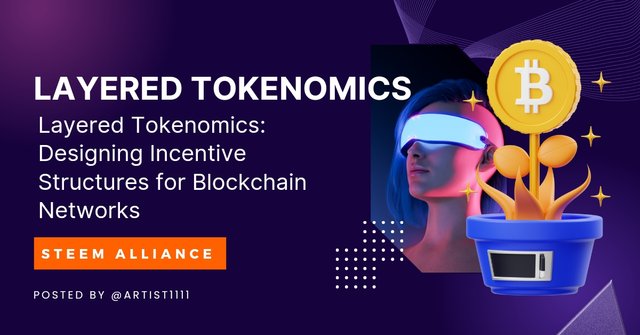Designing Incentive Structures for Blockchain Networks
Layered tokenomics is an advanced method of compensating participants in blockchain networks. This tactical planning includes the development of several incentive tiers or levels that are customized for different ecosystem players.
We'll delve into the topic of layered tokenomics in this piece, looking at how it affects network resilience, token distribution, and usage at different stages of a blockchain ecosystem.

Canvas source Layered tokenomics is the process of creating complex incentive mechanisms inside blockchain networks.
These structures are made up of several levels, each of which has an independent function in motivating various ecological players.
Tokens, for example, might be awarded to producers for their efforts to validate transactions and secure the network, while incentives are going to be given to developers for creating and managing decentralized applications (DApps).
In a similar vein, token awards for involvement and contribution could work as an approach to encourage users to interact with the network.

A number of issues, including the rates of inflation, governance systems, and token distribution, must be thoughtfully taken into account when creating incentive structures for digital currency networks.
With layered tokenomics, incentive structures may be tailored to the particular requirements and goals of the network. To maintain the safety of networks, a network can, for instance, give miners a fraction of recently created tokens as block rewards.
Tokens may also be reserved for the creation of ecosystems or community projects at the same time, supporting an equitable allocation of rewards among different kinds of stakeholders.
Because layered the field of tokenomics provide rewards for a variety of roles throughout the whole ecosystem, it promotes tolerance and engagement. Users, programmers, investors, and validators are all motivated to support the expansion and prosperity of the network.
In along with encouraging active engagement, this multi-layered strategy also fosters a sense of personal responsibility and interest synchronization among stakeholders.

Moreover, layered tokenomics improves the long-term robustness and sustainability of blockchain networks by minimizing dependency on any one category of stakeholders and diversifying incentive sources.
There are various benefits that multilayered tokenomics provides to the blockchain networks. First of all, it offers adaptability and flexibility, helping projects to adjust incentive schemes within response to shifting neighborhood dynamics and market situations.
Second, by compensating different participants according to their roles and contribution, layered tokenomics increases inclusivity and builds an additional dynamic and diversified ecosystem.
Last but not least, layered tokenomics improves network resilience and stability, reducing risks and guaranteeing sustainable growth over time by diversifying incentive sources and synchronizing interests amongst various stakeholder groups.
To sum up, layered the area of tokenomics is an advanced framework for creating reward systems under the framework of blockchain networks. Projects can encourage a robust and vibrant the environment where all members are incentivized to make meaningful contributions to the development and sustainability of the network by implementing different types of incentives suited to diverse stakeholders.
Kind Regards
@artist1111

Adieu, folks!
May the winds of fortune
carry you to greatness!
May the winds of fortune
carry you to greatness!
X-promo : https://twitter.com/HamadkhanMWT/status/1788632056131436603?t=pQLyYGWVYujutN23HW5mpg&s=19
Note:- ✅
Regards,
@jueco